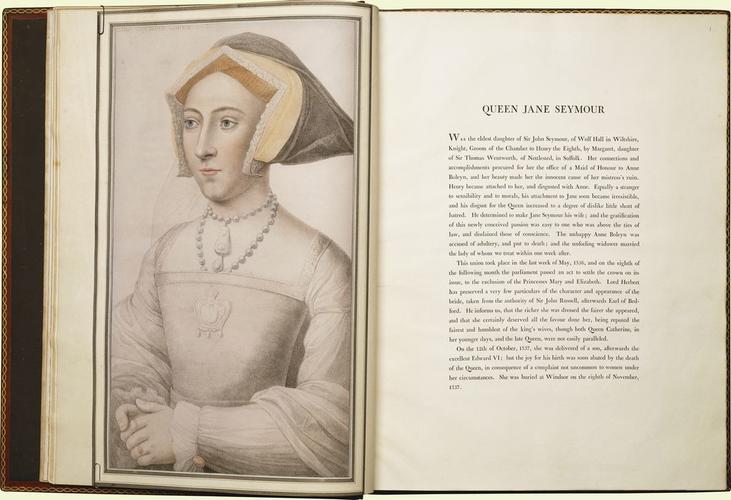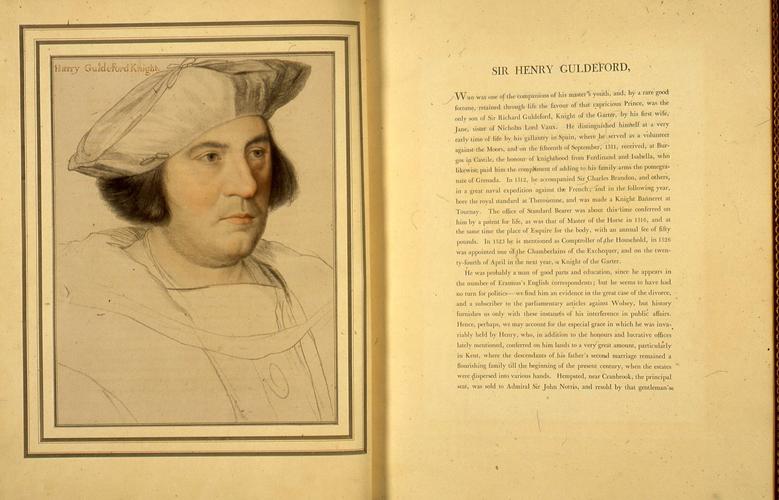Imitations of original drawings by Hans Holbein, in the collection of His Majesty 1792
55.0 x 43.2 cm (book measurement (conservation)) | RCIN 809364

After Hans Holbein the Younger (1497/8-1543)
Imitations of original drawings by Hans Holbein, in the collection of his Majesty for the portraits of illustrious persons of the court of Henry VIII, with biographical tracts 1792

After Hans Holbein the Younger (1497/8-1543)
Imitations of original drawings by Hans Holbein, in the collection of his Majesty for the portraits of illustrious persons of the court of Henry VIII, with biographical tracts 1792



-
In two volumes. Printed book with engravings. Bound in brown calf, gold tooled, rebacked in red goatskin.
The appearance of Chamberlaine’s Imitations of Holbein’s portrait drawings in the Royal Collection was an important landmark in making public the contents of that great collection. Holbein’s drawings - originally housed in a ‘great book’ - had passed in and out of royal ownership since the mid-sixteenth century, finally returning there before 1675. They were ‘rediscovered’ in a bureau in Kensington Palace in 1727 by George II’s wife, Caroline of Ansbach, who framed and hung them at her favourite residence, Richmond Lodge; by the 1740s they had been returned to Kensington; under George III they were unframed and remounted in two volumes. During these years several unsuccessful attempts were made (particularly by George Vertue) to publish the drawings. Between 1774 and his death in 1791, Richard Dalton - George III’s first Librarian - had engraved copies of thirty-five of Holbein’s drawings. Thirty-three of these plates were published by W. Richardson in 1792 as The Court of Henry the Eighth; there are loose impressions of a number of subjects in the Royal Collection and the British Museum. The quality of Dalton’s reproductive prints was uniformly poor.
On Dalton’s death in February 1791, Chamberlaine was appointed Keeper of Drawings and Medals to the King, working alongside the Librarian, Frederick Augusta Barnard (who assumed the additional responsibility of the drawings and medals on Chamberlaine’s death). The eighty-four plates included in Chamberlaine’s Imitations of Holbein’s drawings were published serially between March 1792 and February 1800; Chamberlaine’s Introduction is dated 4 June 1800, which is the date of the publication of the complete series. The publication appeared in fourteen parts; each part included six plates, with accompanying text by Edmund Lodge, Lancaster Herald. All but four of the plates were engraved by Francesco Bartolozzi, the Florentine engraver transported to England by Dalton in 1764 and ‘bound’ to work for Dalton for the following three years. In 1768 Bartolozzi was appointed engraver to the King; he signed most of his Holbein plates as ‘Historical Engraver to his Majesty’.
The first important series of reproductive prints relating to drawings in the Royal Collection was Bartolozzi’s engraving after drawings by Guercino; these were probably partly produced in Italy, shortly before the King’s purchase of the original drawings. After the Imitations of Holbein’s drawings, Chamberlaine published a selection of the King’s other Old Master drawings as Original Designs of the Most Celebrated Masters of the Bolognese, Roman . . . Schools, issued serially between 1795 and 1807. He acted as publisher, editor and general co-ordinator of both these publications.
The opening pictured here shows Bartolozzi’s reproduction (issued in March 1795) of Holbein’s study of 1536/7 for his portrait of Jane Seymour, third consort of Henry VIII and mother of Edward VI. She was originally lady-in-waiting to Henry’s previous Queens, Catherine of Aragon and Anne Boleyn, and married the King in 1536. She died shortly after giving birth to the King’s son and is said to have been Henry VIII’s favourite wife.
Although the advertisement for Chamberlaine’s publication stressed its importance for connoisseurs and artists - many of whom ‘have never heard that such a collection is extant, and very few indeed have ever seen the originals’ - the text accompanying the individual plates provides historical and genealogical information concerning the sitters. In the circumstances, it was not surprising that Holbein’s drawings were ‘completed’, and the colouring enhanced, by Bartolozzi. The folio publication was reissued in 1823. At the Prince Regent’s suggestion, a quarto edition was issued in 1812.
Catalogue entry adapted from George III & Queen Charlotte: Patronage, Collecting and Court Taste, London, 2004.Provenance
Presumably presented by John Chamberlaine to George III around 1800
-
Creator(s)
(publisher)(printer)Acquirer(s)
-
Medium and techniques
Measurements
55.0 x 43.2 cm (book measurement (conservation))
Alternative title(s)
Imitations of original drawings by Hans Holbein, in the collection of his Majesty for the portraits of illustrious persons of the court of Henry VIII, with biographical tracts.







